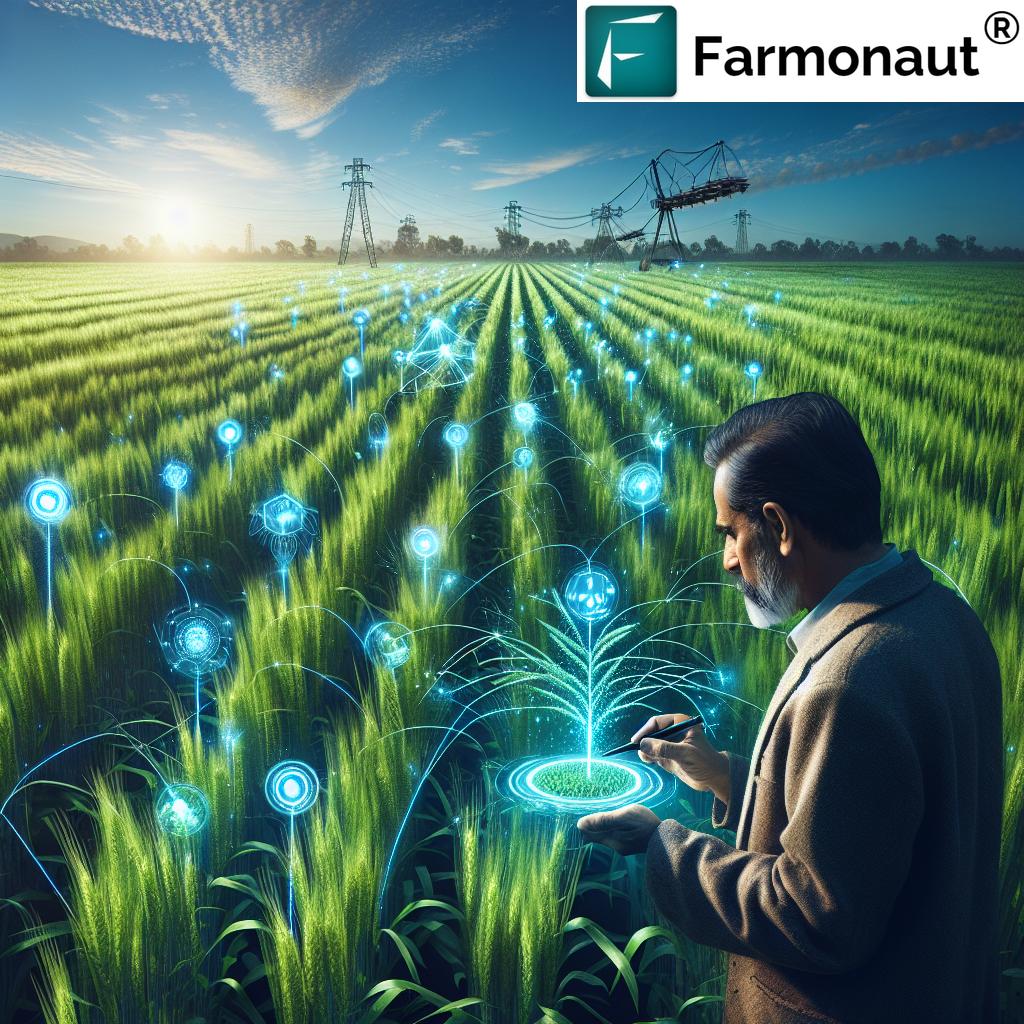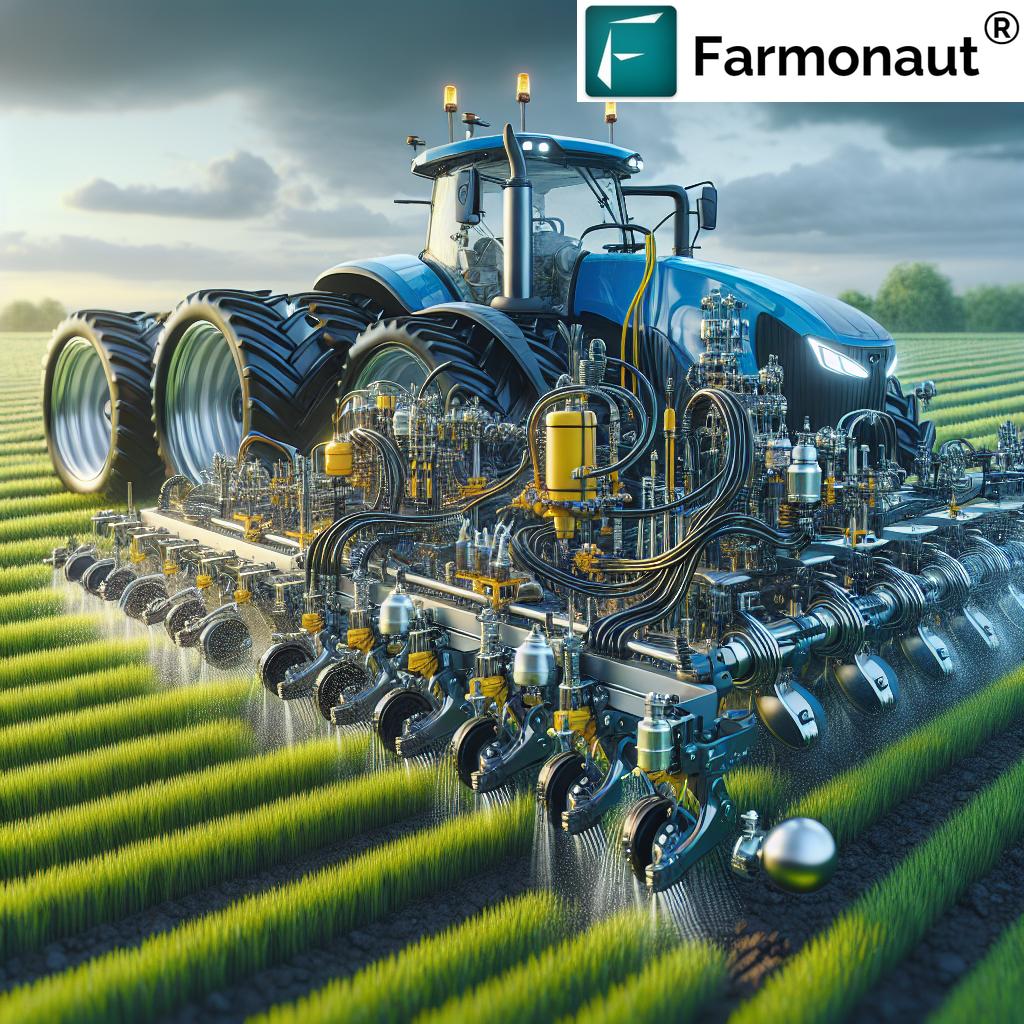Smart Agriculture Monitoring System Using IoT: Top Benefits For 2025
Introduction: The IoT-Based Revolution in Smart Agriculture Monitoring
In the recent years, the agricultural sector has experienced a significant transformation through the integration of Internet of Things (IoT) technologies. This shift is giving rise to the smart agriculture monitoring system using IoT paradigm, which is revolutionizing traditional agricultural practices by enabling real-time monitoring, precision data, and automation across farmlands worldwide. As we steadily approach 2025, the adoption of IoT-based monitoring systems is becoming a cornerstone of modern, sustainable, and highly efficient farming.
This blog comprehensively explores how an IoT-based smart agriculture monitoring system elevates crop management, resource efficiency, and data-driven sustainable farming. We’ll delve into the core technologies, essential benefits, implementation strategies, challenges, and future trends, providing clear explanations, actionable insights, and relevant resources for farmers, agronomists, and tech innovators.
Focus Keyword: Smart Agriculture Monitoring System Using IoT
Understanding the Smart Agriculture Monitoring System Using IoT
A smart agriculture monitoring system using IoT is a technological ecosystem that connects sensors, devices, and communication networks to gather, transmit, and analyze critical environmental data — all in real time. This approach transforms crop monitoring and smart farming using IoT into an efficient, scalable, and sustainable venture by allowing farmers to make data-driven decisions throughout their daily operations.
Key focus areas of IoT-based monitoring systems in smart agriculture include:
- Continuous agronomic data collection (soil moisture, temperature, humidity, light intensity, and nutrient levels)
- Remote control and automation (irrigation, fertilization, and pest management)
- Advanced analytics and machine learning (for predictive insights and optimization)
- Accessible dashboards and mobile apps (for seamless management and real-time alerts)
Such IoT-based smart agriculture monitoring systems are not just futuristic—they are already being adopted globally, with the promise of large-scale transformation as we move into 2025 and beyond.
Key Components of IoT-Based Smart Agriculture Monitoring Systems
To harness the full potential of crop monitoring and smart farming using IoT, it’s essential to understand the foundational blocks that comprise an IoT-based monitoring system in smart agriculture.
1. Network of Sensors and Interconnected Devices
- Soil Moisture Sensors: Measure precise water content at different soil depths, enabling smart irrigation scheduling that prevents resource waste.
- Temperature and Humidity Sensors: Provide crucial environmental data for optimizing planting times and disease forecasting.
- Light Intensity Sensors: Assess sunlight exposure for each crop zone, helping to optimize photosynthesis and yield.
- Nutrient Level Sensors: Continuously monitor soil fertility, ensuring balanced fertilization while minimizing chemical usage.
- Drones Equipped with Multispectral Cameras: Capture high-resolution images for plant health, pest scouting, and stress detection across expansive farmlands.
- Weather Stations: Record and transmit hyperlocal weather patterns, enabling proactive scheduling of critical operations.
2. Wireless Communication Network
- Facilitates seamless transmission of data from in-field sensors to a centralized cloud platform or edge computing gateway for immediate analyses.
- Common connectivity protocols include LoRaWAN, NB-IoT, 5G, and traditional GSM, chosen based on farm size, geography, and network reach.
3. Centralized Cloud Platform and Advanced Analytics
- Aggregates, archives, and analyses field data using machine learning algorithms to deliver actionable insights, alerts, and trend reports.
- Supports predictive analytics, crop modeling, and anomaly detection, empowering farmers with decision intelligence.
4. Mobile and Web Dashboard Applications
- Provide an intuitive interface for real-time monitoring, visualization, and management of farm operations—even remotely.
- Custom alerts for irrigation control, fertilizer application, pest scouting, and harvesting schedules
5. Actuators for Automation
- Integrate with smart agricultural monitoring systems using IoT to enable the automated operation of irrigation pumps, fertigation units, and greenhouse climate controls, further reducing labor costs and enhancing precision.
Top Benefits of Smart Agriculture Monitoring System Using IoT
A smart agriculture monitoring system using IoT offers a comprehensive range of advantages that have the potential to optimize resource usage, increase productivity, and promote sustainable farming practices worldwide. The following are some of the most important benefits transforming the agricultural sector:
1. Precision Farming and Input Optimization
- Reduced Input Waste: Sensors and analytics guide the precise application of water, fertilizers, and agrochemicals, enhancing yields while reducing environmental impact.
- Zone-Based Management: Different sections of the farm can be monitored and managed independently for maximum efficiency based on real-time conditions.
- Data-Driven Decisions: Actionable insights from past and present data help farmers plan accurate irrigation, fertilization, and spraying schedules.
2. Enhanced Productivity and Higher Crop Yields
- Smart system intervention—via crop monitoring and early warning—leads to fewer losses and improved harvest outcomes.
- Yield prediction enabled by machine learning algorithms helps farmers plan harvests and meet market demand confidently.
3. Water Conservation and Efficiency
- Real-Time Soil Moisture Monitoring: Prevents over-irrigation, conserving water resources by up to 50% (according to industry studies).
- Smart scheduling ensures every zone receives water only when required, a critical factor given increasing worldwide water scarcity concerns.
4. Proactive Crop Health and Pest Management
- Advanced surveillance via drones equipped with multispectral cameras allows detecting plant stress, pest infestation, or nutrient deficiencies earlier than traditional methods.
- This enables timely intervention, reducing chemical usage and improving food safety.
5. Automation and Remote Management
- Remote monitoring and automated control of farm equipment and resources—irrigation systems, climate control in greenhouses, and more—streamline operations and lessen dependency on manual labor.
- Allows farmers to manage multiple sites simultaneously, increasing scalability.
6. Sustainable Resource Management
- Minimizes runoff and reduces the environmental footprint of farming through targeted applications of water and chemicals.
- Long-term soil health and biodiversity are preserved via data-driven conservation planning.
7. Risk Reduction and Climate Resilience
- Weather stations and analytics anticipate adverse conditions (drought, floods, frost), allowing preemptive measures.
- Smart forecasting and real-time monitoring improve resilience and adaptation in an increasingly unstable climate.
8. Improved Decision Making Through Advanced Analytics
- Historical and real-time data analysis reveals patterns, optimizes rotations, and improves long-term strategic planning.
- Dashboards and actionable alerts enable farmers and agronomists to make informed operational decisions quickly.
Comparative Table: Traditional Agriculture vs. IoT-Based Smart Agriculture Monitoring System
| Aspect | Traditional Agriculture | With IoT Monitoring System | Estimated Improvement |
|---|---|---|---|
| Crop Yield | Manual estimates; subject to unpredictability and loss | Optimized inputs and zone-specific management boost harvests | +20% increase |
| Water Usage Efficiency | Fixed or manual irrigation schedules; high wastage | Real-time soil moisture sensors, smart irrigation | 50% reduction in water use |
| Fertilizer / Pesticide Optimization | Uniform application; likely overuse or underuse; environmental risks | Precision, need-based application guided by sensor data | 30% less input required; fewer negative effects |
| Labor Requirements | High labor costs; constant supervision | Remote access, automation, reduced supervision | 30–40% labor savings |
| Disease Detection Speed | Visual/manual inspection; delays and losses | Real-time alerts, multispectral surveillance | Immediate detection vs. 2–5 days delay |
How Farmonaut Empowers Smart Agriculture Monitoring System Using IoT
We at Farmonaut are committed to accelerating the adoption of smart agriculture monitoring systems using IoT, providing satellite-driven insights that complement in-field sensor data with advanced analytics. Our solutions democratize access to modern farming tools and are accessible across Android, iOS, web platform, and APIs.
- Satellite-Based Monitoring: Our platform uses multispectral satellite imagery to monitor crop health, moisture, and nutrient status across vast areas, filling in coverage gaps where ground-based devices may be sparse.
- Jeevn AI Advisory System: Real-time AI recommendations, predictive weather, and operational insights for smarter decisions straight from robust cloud analytics.
- Blockchain Product Traceability: We integrate blockchain-based traceability for agriculture supply chains—ensuring transparency, authenticity, and data integrity.
- Fleet and Resource Management: Manage agricultural fleets and equipment for efficiency, safety, and cost reduction using real-time position and usage analytics from our dashboard suite.
- Carbon Footprint Tracking: Monitor the environmental impact of agricultural activities and adopt more sustainable practices via satellite-based emission reports and compliance analytics.
- Crop Loan and Insurance Assistance: Speed up loan and insurance processing for farmers and agri-finance institutions by leveraging accurate, satellite-verified crop status and field boundaries.
- Large Scale Farm Management: Empowers businesses and cooperatives to monitor and manage thousands of farms—improving strategic planning, resource allocation, and reducing losses across expansive agricultural networks.
- API Integration: Developers can instantly access our API or review API Developer Docs to embed satellite weather and crop health intelligence into their own apps or farm management tools.
Practical Applications and Automation in Smart Agriculture Monitoring System Project
A typical smart agriculture monitoring system project leverages IoT devices and automation to deliver:
- Automated Precision Irrigation: Soil moisture sensors trigger irrigation only when and where it’s needed—reducing labor and cutting water bills, while improving growth consistency.
- Dynamic Fertilization: Nutrient sensors assess real-time soil health; fertilizer dosing equipment responds automatically, ensuring crops receive the right nutrients at the right time.
- Pest and Disease Early Warning: Drones with multispectral cameras identify hotspots of pest activity or crop stress, guiding field scouting and targeted treatments before issues escalate.
- Climate Smart Greenhouse Management: Environmental sensors and actuators maintain ideal humidity, light, and temperature settings, regardless of external fluctuations, maximizing productivity inside protected cropping environments.
These innovations optimize input usage, enhance productivity, and foster sustainable management of both small plots and large-scale agricultural enterprises as 2025 approaches.
Environmental Impact and Sustainability: Promoting Responsible Farming
Sustainable agriculture is impossible without responsible resource management.
The IoT-based smart agriculture monitoring system directly addresses environmental challenges:
- Reduced Water Consumption: Field-level data on soil moisture ensures every drop counts, slashing unnecessary irrigation, conserving aquifers, and protecting local ecosystems.
- Targeted Chemical Use: Automated alerts and precision application minimize runoff and pesticide drift, lowering environmental toxicity risks and improving food safety margins.
- Promotion of Soil Health: Data-driven planning fosters crop rotation and reduces over-fertilization, maintaining fertile soils and supporting long-term productivity.
- Lower Carbon Footprint: Smart farm machinery scheduling and sensor-based resource management drive down fossil fuel and agrochemical consumption.
- Biodiversity Enhancement: Fewer broad-spectrum chemical treatments help retain beneficial insect and microbial life within agricultural landscapes.
Discover more on how our solutions enable carbon footprinting for sustainable farm management: Farmonaut Carbon Footprinting Product Page
Scaling IoT Monitoring in Smart Agriculture: Trends Towards 2025
The future of IoT-based monitoring systems in smart agriculture is brighter than ever:
- Advances in Sensor Technology: Low-cost, high-precision wireless sensors will allow even smallholder farmers to deploy robust monitoring networks economically.
- Edge Computing and Real-Time Analytics: By processing field data closer to source, edge computing reduces lag, costs, and connectivity dependency for instant field insights.
- 5G and Beyond for Rural Connectivity: Upcoming generations of wireless communication infrastructure will unlock the full speed and reliability required for farm-wide, real-time automation and management.
- Integrated Satellite and Ground Observations: Combining nanosats, drones, and in-ground sensors paints a holistic, dynamic picture of crop and soil health across farms both small and large.
- Widespread API-First Integrations: Open APIs will simplify assimilating IoT-based data and analysis into third-party applications for customized, scalable farm solutions & monitoring systems.
- Global Adoption: North America, Europe, and Asia-Pacific are leading the charge, but tailored, cost-effective platforms like Farmonaut are accelerating implementation across Africa, Latin America, and beyond.
Farmonaut Subscription Plans: Affordable IoT-Ready Crop Monitoring for All
Addressing IoT Challenges in Smart Agriculture Monitoring
Despite evident benefits, some persistent challenges can slow the adoption of IoT-based monitoring systems in agriculture, especially in developing regions:
- Connectivity Issues: Reliable, affordable internet is essential for real-time transmission of sensor data and cloud analytics. Solutions include deploying edge devices, mesh networks, and leveraging wide-reaching 5G technologies.
- Data Security: As farms become increasingly digitized, protecting sensitive data from breaches and abuse is critical. Secure hardware, encrypted communication, and robust authentication protocols are must-haves.
- User-Focused Design: User interfaces, dashboards, and mobile apps must be intuitive, minimizing learning curves for farmers with varying technological backgrounds.
- Integration Complexity: As both legacy and new systems converge, smooth, API-first integrations with farm management and government platforms become essential.
- Cost and Accessibility: Affordability is more feasible than ever, but widespread rollout of low-cost hardware, coupled with value-based SaaS models (as offered by Farmonaut’s modular approach), is key to true democratization.
- Awareness and Training: On-ground extension services and in-app training modules can boost confidence and skills for farmers embracing the smart agriculture revolution.
FAQ: Smart Agriculture Monitoring System Using IoT
Q1. What is a smart agriculture monitoring system using IoT?
Answer: It’s an ecosystem where wireless sensors, drones, and devices collect, transmit, and analyze real-time data on soil, crops, water, and environment, empowering precision farming, automation, and sustainable management via cloud-based analytics and user-friendly dashboards.
Q2. How does IoT transform traditional farming?
Answer: By using interconnected sensors and analytics, IoT systems shift farming from guesswork to data-driven decisions—optimizing every operation, cutting waste, automating routine tasks, and increasing profitability and sustainability in the agricultural sector.
Q3. What are the critical parameters monitored?
Answer: Key parameters include soil moisture, nutrient levels, temperature, humidity, light intensity, pest infestations, weather events, and plant health indexes, all in real time.
Q4. Is it expensive or complicated to implement?
Answer: With modern solutions and platforms such as Farmonaut, deploying smart, IoT-ready agriculture monitoring systems has become affordable, scalable, and user-friendly for everyone from smallholders to large agribusinesses.
Q5. How can Farmonaut’s platform be accessed?
Answer: You can use Farmonaut’s web browser, Android or iOS app, or integrate our Satellite & AI insights through our robust API for tailored farm monitoring. Get started here.
Conclusion: Shaping the Future of Agriculture with IoT-Based Monitoring Systems
The smart agriculture monitoring system using IoT is rapidly becoming an indispensable foundation for modern, sustainable, and resilient farming as we move into 2025 and beyond. By fusing sensors, satellite imagery, machine learning, and cloud platforms, these systems are driving dramatic improvements in crop yields, resource efficiency, and environmental stewardship.
We believe the future of farming will be defined by data, connectivity, and automation. Our commitment at Farmonaut is to continue making these technologies accessible, scalable, and transformative for all farmers worldwide.
- Ready to optimize your fields with the latest IoT-ready monitoring? Try Farmonaut’s satellite and AI-based solutions here.
- Need advanced traceability or compliance? Discover Farmonaut Product Traceability.
- See how greenhouse gas tracking works in agriculture: Farmonaut Carbon Footprinting Module.
- Automate your farm’s resource, fleet, and operations management: Farmonaut Fleet Management Service.
- Explore weather and satellite-powered crop insurance: Farmonaut Crop Loan and Insurance Support.
- Manage multi-farm operations or agribusinesses with ease: Farmonaut Large Scale Farm Management Platform.
- Developers & Agritech Startups: Access Farmonaut’s API and Developer Docs for seamless integration.
IoT, advanced analytics, satellite intelligence, and smart automation are here to stay—reshaping agriculture at every level. Whether you are starting a new smart agriculture monitoring system project, integrating your farm with API-based insights, or optimizing existing operations, the opportunities in 2025 and beyond have never been greater.














How fascinating to see how IoT and AI-driven monitoring